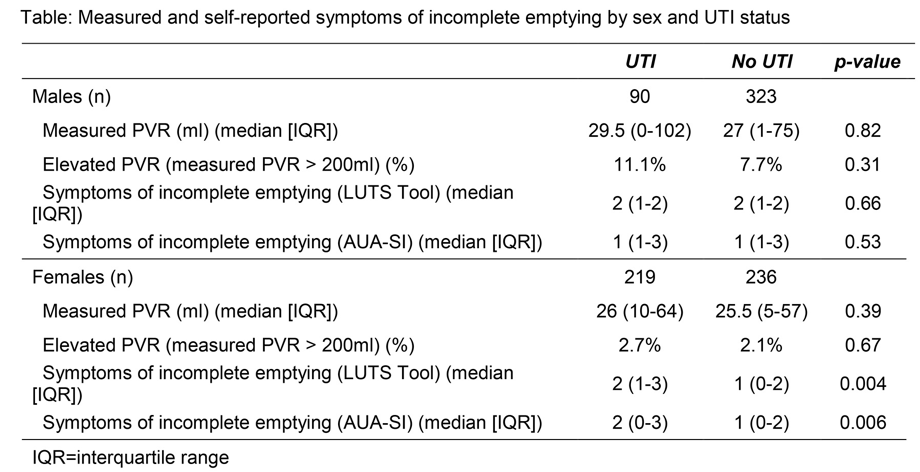However, Andrew Peterson, MD, of Duke University reported findings from the Symptoms of Lower Urinary Tract Dysfunction Research Network (LURN) Observational Cohort Study, in which elevated post-void residual volumes were not found to be associated with self-reported urinary tract infections.
The LURN Observational Cohort Study includes men and women seeking care for LUTS at one of six participating tertiary care centers between 2015 and 2017. Subjects included in the study were at least 18 years of age with at least one urinary symptom based on the LUTS Tool, and patients with neurologic disease, psychiatric disorders, interstitial cystitis, a history of a prostate biopsy, or pregnant at the time of evaluation were excluded from analysis.
Data collection at baseline included a standard clinical exam, medical history including urinary, pelvic floor, and psychiatric symptoms, quality of life assessment, and PVR measurement either by ultrasound or by catheterization. A self-reported history of UTIs was also collected; women were asked if they had ever had more than two UTIs in the past year, and men were asked if they had ever had any UTIs in their lifetime.

The study included 880 people (464 female, 416 male). 48% of women reported more than 2 UTIs over the previous year, and 22% of men reported having had a UTI in their lifetime (see Table). Median measured PVR was not different by UTI status for males or females (median PVR [ml] for UTI vs. no UTI: 29.5 vs. 27 for males and 26 vs. 25.5 for females). There was no difference in elevated PVR (>200ml) by UTI in either sex (11.1% vs. 7.7% in males and 2.7% vs. 2.1% in females).
Based on the results from the LURN network, more women reported a history of UTIs compared to men, but the median measured PVR was not different by recurrent UTI status in either men or women. The authors concluded that an elevated PVR may not be associated with recurrent urinary tract infections.
Presented by: Andrew Peterson, MD, Duke University, Durham, NC
Co-Authors: Abigail R. Smith PhD, Ann Arbor, MI, Matthew O. Fraser PhD, Durham, NC, Claire C. Yang MD, Seattle, WA, John O.L. DeLancey MD, Brenda W. Gillespie PhD, Ann Arbor, MI, John L. Gore MD MS, Seattle, WA, Pooja Talaty MS MHA, Glenview, IL, Victor P. Andreev PhD DSc, Anca Stefan PhD, Ann Arbor, MI, Karl J. Kreder MD MBA, Iowa City, IA, Margaret G. Mueller MD, Chicago, IL, H. Henry Lai MD, St. Louis, MO, Bradley A. Erickson MD MS FACS, Iowa City, IA, Ziya Kirkali MD and the LURN Study Group, Bethesda, MD
References:
1. O’Grady F, Cattell WR. Kinetics of urinary tract infections II. The bladder Br J Urol. 1996;38:156–62.
2. Stern JA, Hsieh Y, Schaeffer AJ. Residual urine in an elderly female population: novel implications for oral estrogen replacement and impact on recurrent urinary tract infection. J Urology 2004 (171): 768–770.
Written by: Judy Choi, MD, Assistant Professor, Department of Urology, University of California, Irvine @judymchoi at the 2018 AUA Annual Meeting - May 18 - 21, 2018 – San Francisco, CA USA


